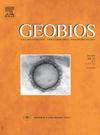墨西哥中部普埃布拉省Pie de Vaca地区火烈鸟化石的新研究及其分类和生物地理意义
IF 1.6
4区 地球科学
Q2 PALEONTOLOGY
引用次数: 0
摘要
Pie de Vaca是位于墨西哥普埃布拉省Tepexi de Rodríguez市的一个晚新生代遗址。它以其鱼类化石记录而闻名,包括骆驼、食肉动物和物种的足迹,以及一具几乎完整的火烈鸟骨架的象形文字。这个化石标本以前被确定为腓尼基,一种小型灭绝物种,通过对胫跗骨的线性骨测量比较。本研究提供了关于象形颅骨印痕的形态学特征的新数据。现存的凤蝶属、凤蝶属和凤凰属在头骨的形态和大小上有所不同。与那些属相比,分析的化石标本显示出一个小脑袋和一个独特的颅骨形状。结果证实该象形文字属于一种小型斑翅类的成虫。基于远端深度与远端宽度之比对胫跗骨的二维形态测量比较表明,该触雕比Phoeniconaias minor和Phoenicopterus minutus更大,与rubber腓翼更相似。这一分析揭示了该象形文字以前不为人知的特征,并反驳了此前将其认定为已灭绝物种stocki腓翼龙的说法。该标本似乎是一只小型成年火烈鸟,但它不同于已知的现存属。这些发现证实了在北美洲和墨西哥晚新生代存在一群小型火烈鸟,其中最完整的标本是Pie de Vaca的象形文字。然而,还需要进一步的研究来确定其与已灭绝和现存的翅翅类的联系。本文章由计算机程序翻译,如有差异,请以英文原文为准。
A new approach to the fossil flamingo from Pie de Vaca locality (Puebla, central México) and some taxonomic and biogeographic implications
Pie de Vaca is a late Cenozoic site located in the municipality of Tepexi de Rodríguez, Puebla, Mexico. It is known for its ichnofossil record including footprints of camelids, carnivores, and peccaries, as well as the taphoglyph of an almost complete flamingo skeleton. This fossil specimen was previously identified as Phoenicopterus stocki, a small extinct species, through linear osteometric comparisons of the tibiotarsus. This study presents new data on the morphological features of the taphoglyph skull impression. The extant genera Phoenicopterus, Phoenicoparrus, and Phoeniconaias differ in the morphology and size of the skulls. The fossil specimen analyzed exhibits a small head and a distinct cranial shape when compared to those genera. The results confirm that the taphoglyph belongs to an adult of a small phenicopterid. The two-dimensional morphometric comparisons of the tibiotarsus based on the ratio of distal depth to distal width shows that the taphoglyph is larger than Phoeniconaias minor and Phoenicopterus minutus, and more similar to Phoenicopterus ruber. The analysis revealed previously unknown characteristics of the taphoglyph and refutes its previous identification as the extinct species Phoenicopterus stocki. The specimen appears to be a small adult flamingo, but it differs from known extant genera. These findings confirm the presence of a group of small flamingos in the late Cenozoic of North America and Mexico, with the most complete specimen being the taphoglyph of Pie de Vaca. However, further research remains necessary to establish its connections with extinct and extant phenonicopterids.
求助全文
通过发布文献求助,成功后即可免费获取论文全文。
去求助
来源期刊

Geobios
地学-古生物学
CiteScore
3.30
自引率
6.20%
发文量
28
审稿时长
6-12 weeks
期刊介绍:
Geobios publishes bimonthly in English original peer-reviewed articles of international interest in any area of paleontology, paleobiology, paleoecology, paleobiogeography, (bio)stratigraphy and biogeochemistry. All taxonomic groups are treated, including microfossils, invertebrates, plants, vertebrates and ichnofossils.
Geobios welcomes descriptive papers based on original material (e.g. large Systematic Paleontology works), as well as more analytically and/or methodologically oriented papers, provided they offer strong and significant biochronological/biostratigraphical, paleobiogeographical, paleobiological and/or phylogenetic new insights and perspectices. A high priority level is given to synchronic and/or diachronic studies based on multi- or inter-disciplinary approaches mixing various fields of Earth and Life Sciences. Works based on extant data are also considered, provided they offer significant insights into geological-time studies.
 求助内容:
求助内容: 应助结果提醒方式:
应助结果提醒方式:


